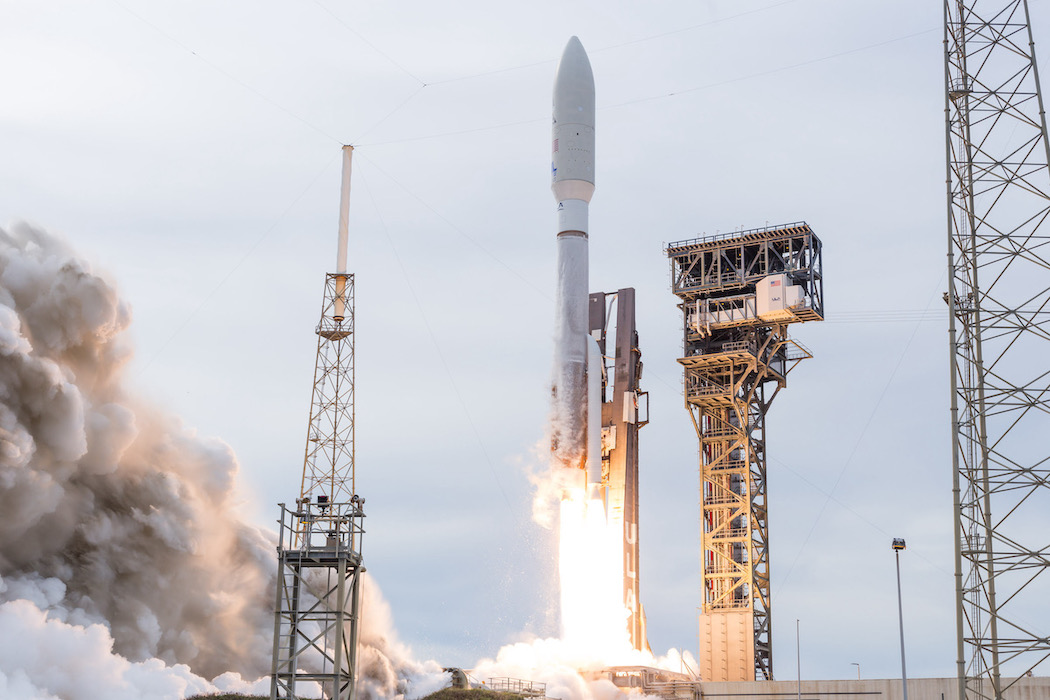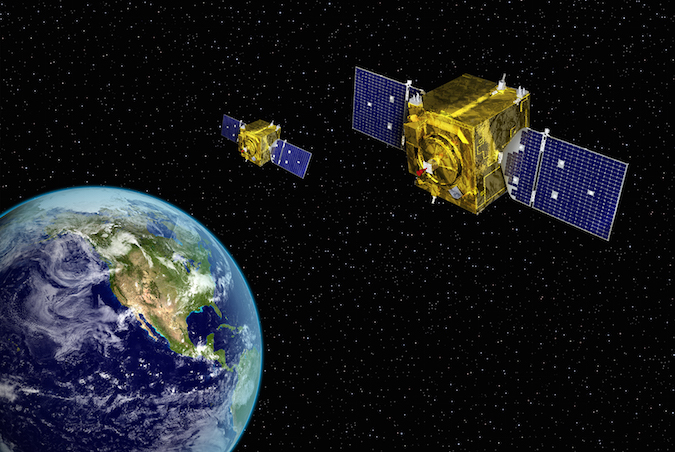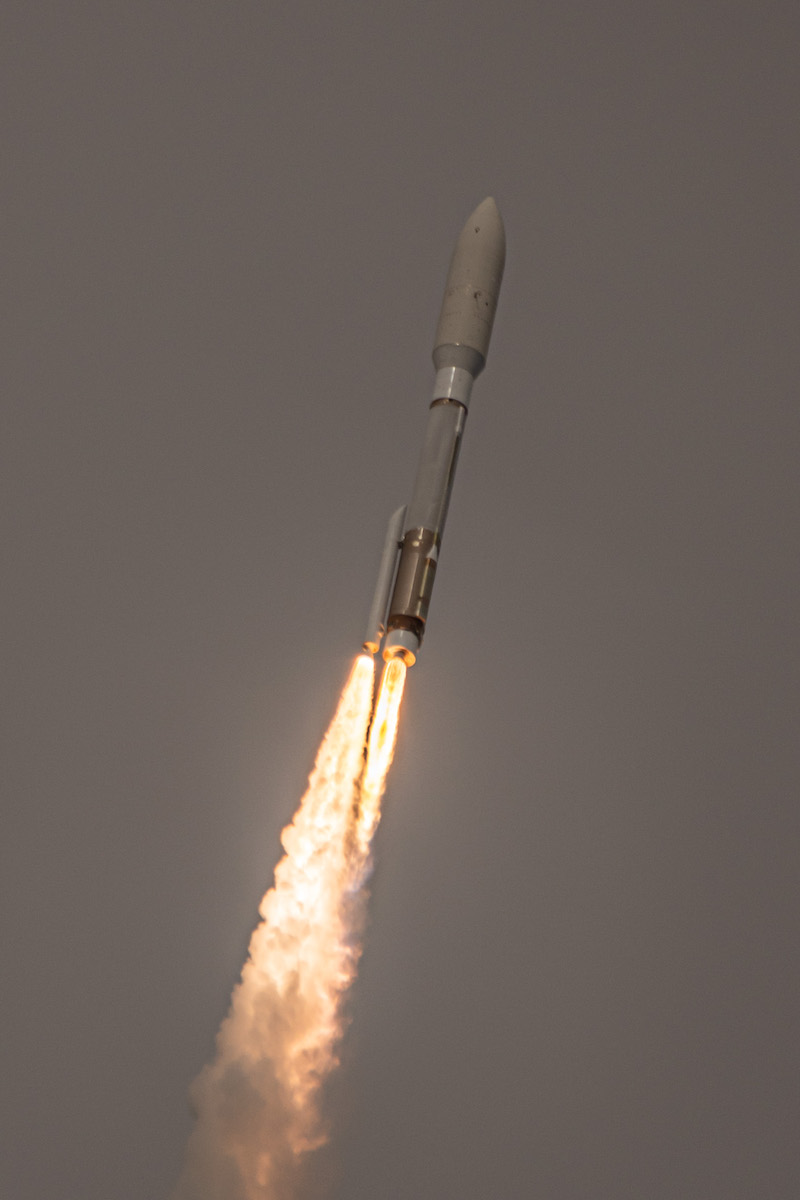
Two satellites for a once-classified U.S. military program to track and inspect other spacecraft in orbit — a mission the Space Force’s top general equates to a “neighborhood watch” — lifted off from Cape Canaveral Friday on top of a United Launch Alliance Atlas 5 rocket.
Bound for an orbit thousands of miles above Earth, the satellites rode side by side in the Atlas 5 rocket’s payload compartment for the climb into space. The two satellites are the fifth and sixth spacecraft to join the Space Force’s Geosynchronous Space Situational Awareness Program.
The GSSAP satellites lurk near the ring of geosynchronous satellites that fly around Earth at the same speed of the planet’s rotation, allowing craft to remain over a fixed geographic location at an altitude of more than 22,000 miles (nearly 36,000 kilometers). Commercial companies and defense agencies use the orbit for communications, missile warning and signals intelligence missions.
Not only can the surveillance platforms help the Space Force track objects in geosynchronous orbit — a capability needed to manage traffic and avoid collisions — the GSSAP spacecraft can adjust their orbits to approach and image other satellites using sharp-eyed optical cameras.
The GSSAP satellites’ ability to maneuver around other spacecraft gives military officials data on the location, orbit and size of other objects in geosynchronous orbit, according to the Space Force, “enabling characterization for anomaly resolution and enhanced surveillance, while maintaining flight safety.”
“Data from GSSAP uniquely contributes to timely and accurate orbital predictions, enhancing our knowledge of the geosynchronous orbit environment, and further enabling space flight safety to include satellite collision avoidance,” officials wrote in the Space Force’s official GSSAP fact sheet.
The new GSSAP satellites launched Friday join four others deployed into orbit by Delta 4 rockets in 2014 and 2016.
ULA’s launch team at Cape Canaveral loaded the 196-foot-tall (59.7-meter) Atlas 5 rocket with liquid propellants during a trouble-free countdown Friday, culminating in startup of the first stage’s Russian-made RD-180 engine and ignition of a single strap-on solid-fueled booster at 2 p.m. EST (1900 GMT).
Liftoff of the Atlas 5 rocket with two satellites to join the US Space Force’s fleet of surveillance satellites tracking objects in geosynchronous orbit. https://t.co/YkxrNrSD8F pic.twitter.com/2X0XfOPUfo
— Spaceflight Now (@SpaceflightNow) January 21, 2022
The two powerplants combined to produce about 1.2 million pounds of thrust, five times the thrust of a Boeing 747 jumbo jet at full throttle, to propel the Atlas 5 rocket through a thin overcast cloud layer and downrange east from Cape Canaveral.
Two minutes after liftoff, the Atlas 5 shed its single Northrop Grumman-built strap-on booster. Three-and-a-half minutes into the mission, the Atlas 5’s payload fairing jettisoned to reveal the mission’s two U.S. Space Force satellites after climbing above the atmosphere.
The RD-180 first stage engine shut down nearly four-and-a-half minutes after liftoff, and the single-use bronze-colored booster stage separated to fall into the Atlantic Ocean. A Centaur upper stage, powered by an Aerojet Rocketdyne RL10C-1 engine, ignited a burn lasting more than eight minutes to reach the required velocity to enter orbit around Earth.
The Centaur stage fired two more times — at T+plus 1 hour, 9 minutes, and at T+plus 6 hours, 30 minutes — to maneuver the GSSAP satellites into their targeted deployment orbit at an altitude of 22,440 miles (36,113 kilometers) over the equator.
The satellites separated from the Centaur upper stage one at a time, and ULA confirmed the final spacecraft separation event at 8:45 p.m. EST Friday (0145 GMT Saturday).
The GSSAP satellites, built by Northrop Grumman, were expected to open their solar panels soon after separating from the Centaur upper stage. Friday’s mission, officially designated USSF 8, was the first launch by ULA this year, and the 91st flight of an Atlas 5 rocket since its inaugural launch in August 2002.
“ULA continues to launch national security assets into highly complex orbits,” said Gary Wentz, ULA’s vice president of government and commercial programs. “The USSF 8 mission was successfully delivered to near-geosynchronous orbit after a nearly 7-hour mission.”
The GSSAP program, which was classified until 2014, produces data that helps military and other government satellites “navigate freely and safely” in geosynchronous orbit, according to the Space Force’s Space Systems Command.

“The first four GSSAP satellites have performed remarkably well,” said Lt. Gen. Stephen Whiting, commander of Space Operations Command. “These next two satellites will add to that capability and enable us to understand more completely things that occur in the geosynchronous orbit. It’s a key piece in the puzzle for space domain awareness.”
The new GSSAP satellites will become sensors in the Space Force’s Space Surveillance Network, which tracks more than 27,000 satellites, derelict rockets, and other pieces of space junk circling Earth.
“The way I describe it is a neighborhood watch capability,” said Gen. John “Jay’ Raymond, the chief of space operations and the highest-ranking officer in the Space Force. “It allows us to better understand what’s going on in the domain, especially in a really critical orbit like geosynchronous orbit.”
Before the establishment of the Space Force, the Air Force sent one of the GSSAP satellites to the aid of a crippled U.S. Navy communications satellite in 2016. The Navy’s fifth MUOS relay satellite ran into propulsion trouble after launch, forcing it to use backup thrusters to climb into its perch in geosynchronous orbit.
The GSSAP satellite changed course to capture imagery of the MUOS 5 spacecraft to give engineers insight into its status and condition, the Air Force said at the time.
“Historically, the way we have surveilled or had awareness of the domain is we’ve taken observations from radars or optical capabilities, and we’ve come up with an address in space, if you will, of objects,” Raymond said Tuesday in a virtual discussion hosted by the Mitchell Institute.
Cataloguing satellites and space debris has been the a chief goal of the military’s space-related efforts for decades. But with countries like China and Russia fielding increasingly sophisticated military spacecraft, including anti-satellite capabilities, the Space Force needs the GSSAP satellites to add a new dimension in its tracking of objects in orbit.
“We’ve been worried about making sure two things don’t collide, that we can keep that domain safe for all, which is critical. But it’s not sufficient,” Raymond said. “If you move into a war fighting domain, you have to have more knowledge than just where something is. You have to have some insights into what those capabilities are, and this neighborhood watch capability has provided us a fuller look at what’s in space, specifically in the geosynchronous domain.”
The fifth and six satellites will provide “additional capacity” for the GSSAP network to better cover the large volume of space in the geosynchronous belt, Raymond said in response to questions from Spaceflight Now.

The rocket used to launch the fifth and sixth GSSAP satellites debuted a new configuration of ULA’s workhorse Atlas 5. The variant combined a single solid-fueled booster with a a 5.4-meter (17.7-foot) diameter payload fairing provided by RUAG Space, and a single RL10 engine on the Centaur upper stage.
This version of the Atlas 5 is known as the “511” configuration, with the first number denoting the size of the payload fairing, the second number representing the number of solid rocket booster, and the third digit the number of engines on the Centaur stage.
The placement of just one strap-on booster on the side of the Atlas 5’s first stage will give the rocket asymmetrical thrust as it climbs off the pad. Atlas 5 missions have flown with a single solid rocket booster before, but those flights used the smaller 4-meter-wide payload fairing option.
The Atlas 5-511 rocket will take off with 1.2 million pounds of thrust from the single solid-fueled booster and the first stage’s kerosene-fueled RD-180 main engine. According to ULA, the Atlas 5-511 can carry up to 11,570 pounds (5,250 kilograms) to an elliptical geostationary transfer orbit. Its capacity to low Earth orbit is roughly 24,250 pounds (11,000 kilograms), according to ULA performance data.
Tory Bruno, ULA’s CEO, calls the “511” version of the Atlas 5 the “Big Slider” because the asymmetrical thrust causes the rocket to “power slide off the pad.”
The launch Friday was the only planned flight of the Atlas 5-511 configuration as the Atlas 5 family nears retirement.
“That nozzle (of the solid rocket booster) is canted to pass through the average center of gravity, and the RD-180 has tremendous control authority with its thrust vector system, and it can overcome that and compensate for it, and this is just the right amount of energy to carry these two payloads to their very cool mission of space surveillance,” Bruno said.
The Atlas 5 rocket was designed by Lockheed Martin to fly in up to 20 different configurations, giving engineers the ability to “dial” the rocket’s power and payload volume to meet the needs of each specific mission. Mission planners have the option of flying a four-meter or five-meter diameter payload fairing, and can fly the Atlas 5 with up to five strap-on solid boosters, or none if the mission doesn’t need them.
The Atlas 5’s Centaur upper stage can fly with one or two RL10 engines, depending on mission requirements. So far, all but one Atlas 5 launch has flown with the single-engine Centaur upper stage.
The exception is on launches with Boeing’s Starliner capsule, which launches with a dual-engine Centaur stage. There are no other missions on the Atlas 5 launch schedule confirmed to use the dual-engine Centaur stage.
The addition of the unique Atlas 5 configuration for Starliner missions and the lack of use of other dual-engine Centaur variants effectively leaves 11 Atlas 5 versions that will have flown at least once before the rocket’s retirement.
Lockheed Martin merged its Atlas rocket program with Boeing’s Delta family in 2006 to create United Launch Alliance.
The most-used version of the Atlas 5 to date is the “401” variant with a four-meter fairing and no solid boosters. The Atlas 5-401 has flown 40 times, including the first Atlas flight in 2002.
There have been six flights of the Atlas 5-411 configuration with a sole solid booster.
With asymmetrical thrust countered by steering from the Atlas 5’s RD-180 main engine, the Atlas 5-511 and -411 configurations are unique among launchers currently in service. The ability to add a single booster allows customers to pay for just enough capacity for their payloads, rather than buying a more larger, more expensive Atlas 5 variant.
ULA is developing the upgraded Vulcan Centaur rocket to replace the Atlas and Delta rocket families.
There are 25 more Atlas 5 rockets remaining in ULA’s inventory, following the launch Friday afternoon. All have been allocated to future missions for the Space Force, NASA, and Amazon’s Kuiper internet satellite constellation.
There are just three Delta rockets left to fly, and all are assigned to carry classified cargo into orbit for the National Reconnaissance Office, the U.S. government’s spy satellite agency.
ULA’s next mission is set for liftoff March 1, when another Atlas 5 will carry a weather satellite into orbit from Cape Canaveral for the National Oceanic and Atmospheric Administration, or NOAA.
Email the author.
Follow Stephen Clark on Twitter: @StephenClark1.
